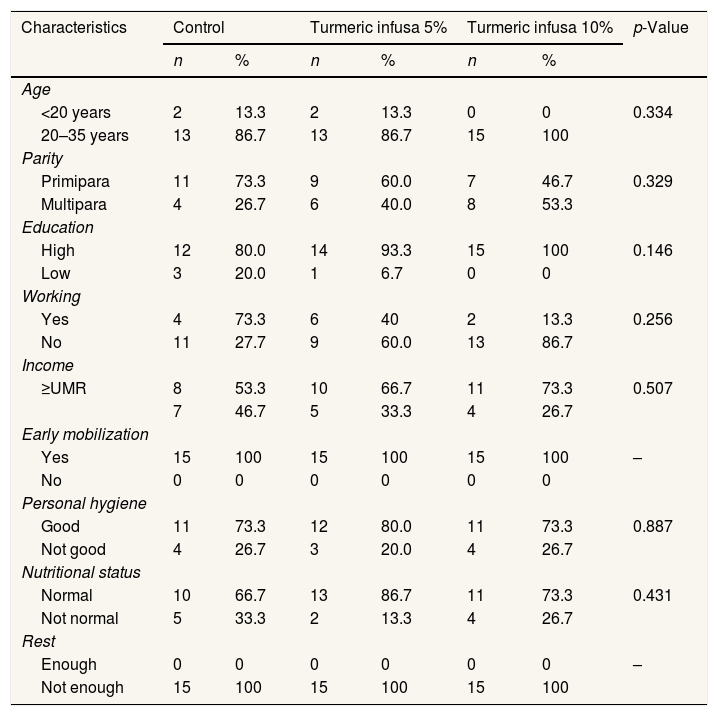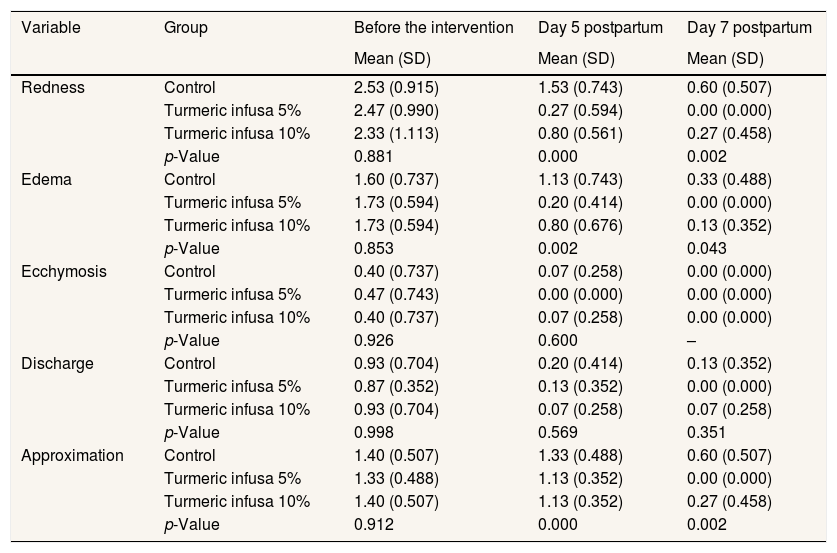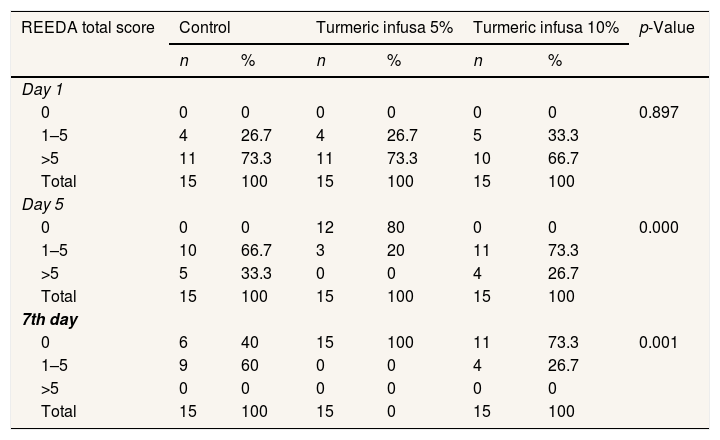
The 3rd International Nursing and Health Sciences Students and Health Care Professionals Conference (INHSP)
More infoThe purpose of this study was to assess the effectiveness of yellow turmeric-infusa of 5% and 10% on the healing process of perineal wound grade II.
MethodThe method used in this study is quasi-experiment with Pretest–Posttest Control Group design. The sampling technique is Exhaustive Sampling according to inclusion criteria. In this research consisted of three experimental groups with two intervention groups and one control group, with the number of subjects group was 15 people. Turmeric infusa is used daily by washing in the perineal wound area two times a day for 5 days postpartum. Monitoring of grade II perineal wound was performed three times, days 1, 5, and 7 postpartum using REEDA scale assessment. Data analysis used Kruskal–Wallis and Chi-Square tests.
ResultsThe results showed that on the 5th and 7th postpartum days, there were differences in redness, edema, and approximation of wounds in each group (p<0.05) while the other REEDA parameters were not significantly different. There is also a difference in the time of perineal wound healing in each group, and it can be seen from the decrease and the total REEDA score. Turmeric infusa group 5% experienced healing on the 5th day postpartum, turmeric infusa 10% recovered on the 7th day postpartum, and the control group recovered more than 7 days.
ConclusionGiving turmeric was proven to eliminate redness, edema, accelerate the closure, and perineal wound healing time, as seen from the p-value (p<0.05). However, turmeric infusa of 5% and 10% showed better effectiveness than turmeric infusa of 5%.
The perineal wound is a tear in the birth canal during labor, whether using or without tools.1 The perineal wound can be divided into one to four-degree injuries.2 First-degree perineal injury only involves the vaginal mucosa or perineal skin. Second-degree injuries involve the muscles of the perineum without exceeding the anal sphincter. Third-degree injury is a tear that occurs in the external anal sphincter, and fourth-degree affects the rectal mucosa.3
A perineal wound causes acute, chronic, and dyspareunia postpartum perineal pain.4 Other impacts include psychological trauma, risk of infection, urinary incontinence/retention, fecal incontinence, and poor quality of life.5 The healing duration of perineal suture wounds lasts 7–10 days and not more than 14 days.6 The prevalence of maternal women who suffer perineal wounds in Indonesia with stitches wound infection by 5%, bleeding by 7%, and death in postpartum mothers by 8%.7
Curcuma longa Linn, commonly known as yellow turmeric, is an essential plant species economically and medically.8 Active ingredients such as curcumin make turmeric an important drug that contains antioxidants, anti-inflammatory, and anti-cancer.9,10 The rhizome of this plant has been used as an anti-diarrhea, anti-vomiting, antipyretic, ointment for boils, sores, and other skin disorders.11,12 The mechanism of action of turmeric extract in wounds is by inhibiting the enzymes cyclooxygenase (COX-2) and lipooxygenase (LOX), which play a role in the inflammatory process, accelerating tissue re-epithelialization, cell proliferation, and collagen synthesis.13 The use of turmeric so far has proven safe, even on high doses, does not cause significant side effects.14
Infusa is a liquid preparation made by extracting vegetable Simplicia with water at 90°C for 15min. The Infudation Method was chosen because it considers its ease of manufacture. The tracer liquid used is water that is easily available, non-toxic, neutral, and easily pulls out active compounds in cells.15
Previous research has shown that the use of red betel leaves in the perineal wound area accelerates wound healing, with mean healing of 4–5 days.6 Other studies use Binahong leaf decoction water on average perineal wound healing for 5 days while povidone Iodine ≥7 days.16 Research on turmeric done on white mice (Ratus norvegicus) with that result administration of turmeric yellow extract 10% ointment to rat wounds for 14 days at a twice-daily dose has the best effect on accelerating wound healing.13 Furthermore, research conducted on bacteria showed results gel administration to incubated bacteria for 36h showed curcumin extract and ethanol of Nyctanthes Abor Tritis leaves have strong in-vitro antibacterial activity. 17 In this study, researchers assessed the effectiveness of turmeric infusa of 5% and 10% as complementary therapies in grade II perineal wounds. The novelty of this research is the preparation of infusa for use as an antiseptic solution—previous research in the form of boiled water.
MethodResearch sitesThis research was conducted in January–March and has received a recommendation of ethical approval with the protocol number UH19121100. The study was conducted at three public health centers in BauBau city, Katobengke, Betoambari, and Wajo health centers
Tools and materialsEquipment used in this study includes infusa pans, measuring cups, water thermometers, stirring rods, scales, and glass bottles. The materials used in this study include water, turmeric taken from the city of BauBau, Southeast Sulawesi province, and flannel
Research DesignThe method used in this study is quasi-experimental (quasi-experimental) with the Pretest–Posttest Control Group design.
Population and sampleThe population in this study were all postpartum mothers with grade II perineal wounds. This study consisted of three groups: two intervention groups and one control group consisting of 15 subjects. The inclusion criteria in this study are as follows, being willing to become a respondent, the first-day postpartum mothers with grade II perineum injuries both spontaneously and episiotomically, while Exclusion Criteria are mothers with certain medical conditions, such as diabetes and anemia.
Research stagesSimplicia turmericSimplicia local turmeric was obtained from the city of BauBau, Southeast Sulawesi. Simplicia that has been collected is then sorted, cleaned from attached soil using flowing water, and then chopped, then dried by aerating it to contain a moisture content below 10%. After drying, sorting is performed again on simplicia. The size of dried turmeric Simplicia was reduced using a grinder. Turmeric symphysis powder is stored in a closed container at room temperature.
Turmeric infusaTurmeric infusa is made by weighing 50g of turmeric powder for a concentration of 5% and 100g of turmeric powder for a concentration of 10%. Mix turmeric Simplicia powder with 1000ml water in the top pan and add enough water to the bottom pan. Heat over the water bath while stirring occasionally. Check the temperature periodically, if it has reached 90°C, heat it for 15min. Infusa containing essential oils are cooled after they cool. After chilling, use a flannel cloth placed on a measuring cup. Enough hot water was added through turmeric pulp to the desired volume of infusa.
Postpartum mother's treatmentLook for research subjects according to inclusion criteria and submit an Informed Consent. On the first day postpartum, the investigator monitored the wound (Pre-Test) using a REEDA scale assessment item. In the intervention group infusa was done every day for 5 days by researchers with a dose of use twice a day, 500ml once washed while the control group was given conventional medicine consisting of amoxicillin 3×1, mefenamic acid 3×1, and vitamin 1×1 also consumed for 5 days.
Data collection techniqueData related to respondent characteristics and assessment of wound healing were collected using a questionnaire and observation sheet. Wound healing was recorded on days 5 and 7 of the postpartum in both the control and intervention groups using the REEDA scale observation sheet.
ResultsTable 1 shows that there were no significant differences in the characteristics of respondents from the three groups, including age, parity, education, occupation, income, early mobilization, personal hygiene, nutritional status, and rest, which can be seen from the p-value>0.005.
Characteristics of respondents by age, parity, education, working, income, early mobilization, personal hygiene, nutrition status, and rest.
| Characteristics | Control | Turmeric infusa 5% | Turmeric infusa 10% | p-Value | |||
|---|---|---|---|---|---|---|---|
| n | % | n | % | n | % | ||
| Age | |||||||
| <20 years | 2 | 13.3 | 2 | 13.3 | 0 | 0 | 0.334 |
| 20–35 years | 13 | 86.7 | 13 | 86.7 | 15 | 100 | |
| Parity | |||||||
| Primipara | 11 | 73.3 | 9 | 60.0 | 7 | 46.7 | 0.329 |
| Multipara | 4 | 26.7 | 6 | 40.0 | 8 | 53.3 | |
| Education | |||||||
| High | 12 | 80.0 | 14 | 93.3 | 15 | 100 | 0.146 |
| Low | 3 | 20.0 | 1 | 6.7 | 0 | 0 | |
| Working | |||||||
| Yes | 4 | 73.3 | 6 | 40 | 2 | 13.3 | 0.256 |
| No | 11 | 27.7 | 9 | 60.0 | 13 | 86.7 | |
| Income | |||||||
| ≥UMR | 8 | 53.3 | 10 | 66.7 | 11 | 73.3 | 0.507 |
| 7 | 46.7 | 5 | 33.3 | 4 | 26.7 | ||
| Early mobilization | |||||||
| Yes | 15 | 100 | 15 | 100 | 15 | 100 | – |
| No | 0 | 0 | 0 | 0 | 0 | 0 | |
| Personal hygiene | |||||||
| Good | 11 | 73.3 | 12 | 80.0 | 11 | 73.3 | 0.887 |
| Not good | 4 | 26.7 | 3 | 20.0 | 4 | 26.7 | |
| Nutritional status | |||||||
| Normal | 10 | 66.7 | 13 | 86.7 | 11 | 73.3 | 0.431 |
| Not normal | 5 | 33.3 | 2 | 13.3 | 4 | 26.7 | |
| Rest | |||||||
| Enough | 0 | 0 | 0 | 0 | 0 | 0 | – |
| Not enough | 15 | 100 | 15 | 100 | 15 | 100 | |
Chi-square test (early mobilization, rest=constant).
Table 2 shows that on the 1st day postpartum, there was no significant difference in the mean REEDA scale in the three groups, as seen from the p-value>0.05. However, on days 5 and 7, postpartum showed significant differences in redness, swelling, and pooling of the wound (p<0.05), while the other REEDA parameters were not significantly different.
Average REEDA scale in the three groups.
| Variable | Group | Before the intervention | Day 5 postpartum | Day 7 postpartum |
|---|---|---|---|---|
| Mean (SD) | Mean (SD) | Mean (SD) | ||
| Redness | Control | 2.53 (0.915) | 1.53 (0.743) | 0.60 (0.507) |
| Turmeric infusa 5% | 2.47 (0.990) | 0.27 (0.594) | 0.00 (0.000) | |
| Turmeric infusa 10% | 2.33 (1.113) | 0.80 (0.561) | 0.27 (0.458) | |
| p-Value | 0.881 | 0.000 | 0.002 | |
| Edema | Control | 1.60 (0.737) | 1.13 (0.743) | 0.33 (0.488) |
| Turmeric infusa 5% | 1.73 (0.594) | 0.20 (0.414) | 0.00 (0.000) | |
| Turmeric infusa 10% | 1.73 (0.594) | 0.80 (0.676) | 0.13 (0.352) | |
| p-Value | 0.853 | 0.002 | 0.043 | |
| Ecchymosis | Control | 0.40 (0.737) | 0.07 (0.258) | 0.00 (0.000) |
| Turmeric infusa 5% | 0.47 (0.743) | 0.00 (0.000) | 0.00 (0.000) | |
| Turmeric infusa 10% | 0.40 (0.737) | 0.07 (0.258) | 0.00 (0.000) | |
| p-Value | 0.926 | 0.600 | – | |
| Discharge | Control | 0.93 (0.704) | 0.20 (0.414) | 0.13 (0.352) |
| Turmeric infusa 5% | 0.87 (0.352) | 0.13 (0.352) | 0.00 (0.000) | |
| Turmeric infusa 10% | 0.93 (0.704) | 0.07 (0.258) | 0.07 (0.258) | |
| p-Value | 0.998 | 0.569 | 0.351 | |
| Approximation | Control | 1.40 (0.507) | 1.33 (0.488) | 0.60 (0.507) |
| Turmeric infusa 5% | 1.33 (0.488) | 1.13 (0.352) | 0.00 (0.000) | |
| Turmeric infusa 10% | 1.40 (0.507) | 1.13 (0.352) | 0.27 (0.458) | |
| p-Value | 0.912 | 0.000 | 0.002 |
Kruskal–Wallis test (day 7 ecchymosis, rest=constant).
Table 3 shows that on the 1st day postpartum, the total REEDA score did not differ between groups. It can be seen from the p-value>0.05. However, on days 5 and 7, there were significant differences in the total REEDA scores between groups, it can be seen in the p-value (p<0.05).
Total REEDA scores for perineal wound day 1, 5, and 7 postpartum.
| REEDA total score | Control | Turmeric infusa 5% | Turmeric infusa 10% | p-Value | |||
|---|---|---|---|---|---|---|---|
| n | % | n | % | n | % | ||
| Day 1 | |||||||
| 0 | 0 | 0 | 0 | 0 | 0 | 0 | 0.897 |
| 1–5 | 4 | 26.7 | 4 | 26.7 | 5 | 33.3 | |
| >5 | 11 | 73.3 | 11 | 73.3 | 10 | 66.7 | |
| Total | 15 | 100 | 15 | 100 | 15 | 100 | |
| Day 5 | |||||||
| 0 | 0 | 0 | 12 | 80 | 0 | 0 | 0.000 |
| 1–5 | 10 | 66.7 | 3 | 20 | 11 | 73.3 | |
| >5 | 5 | 33.3 | 0 | 0 | 4 | 26.7 | |
| Total | 15 | 100 | 15 | 100 | 15 | 100 | |
| 7th day | |||||||
| 0 | 6 | 40 | 15 | 100 | 11 | 73.3 | 0.001 |
| 1–5 | 9 | 60 | 0 | 0 | 4 | 26.7 | |
| >5 | 0 | 0 | 0 | 0 | 0 | 0 | |
| Total | 15 | 100 | 15 | 0 | 15 | 100 | |
Chi-square test.
The graph shows that there are differences in the acceleration of perineal wound healing in each group; it can be seen from the decrease in the total REEDA score (score=0). For example, turmeric infusa group 5% on average healed on the 5th day postpartum by 12 people, turmeric infusa group 10% on average healed on the 7th postpartum day by 11 people, and the control group had average healing of >7 days by 9 people.
DiscussionThe results showed that there was a difference in the time of perineal wound healing in each group, it can be seen from the decrease in the total REEDA score. Turmeric infusa group 5% on average healed on the 5th day postpartum as many as 12 people (80%), turmeric infusa group 10% on average healed on the 7th postpartum day as many as 11 people (73.3%), and groups control on average experienced healing >7 days by 9 people (60%). Administration of turmeric has been proven to reduce redness, edema, and accelerate wound closure, with significance (p<0.05).
Herbal formulation with one turmeric in it can inhibit cyclooxygenase and lipoxygenase, which plays a role in the inflammatory process of the wound.18 Some evidence from in vitro and in vivo studies has shown that curcumin contained in turmeric can modulate physiological and molecular events during the inflammatory phase. In addition, it also provides antioxidant effects by restoring an imbalance between the production of ROS (free radicals) and antioxidant activity. In the proliferative phase, curcumin can produce collagen synthesis of fibroblast migration, vascular density, and epithelialization.19,20 Curcumin has also been shown to have pro-angiogenic properties in wound healing by inducing TGFβ, angiogenesis, and accumulation of extracellular matrix, which continues in the wound repair phase.21
The ideal antiseptic characteristic is that it can kill micro-organisms in a wide range, remains effective against various kinds of dilution, is non-toxic to the human body, does not easily cause sensitivity reactions, both local and systemic, reacts quickly, works efficiently. Even though there are organic, is inexpensive and durable.22 Herbal preparations in this research in the form of infusa. The choice of infusa preparation is based on the condition of the perineum wound, which is still wet and mixed with lochia, which is susceptible to infection and sensitivity reaction when using topical preparations.
In general, the physiological healing of the perineal wound during the puerperium takes 6–7 days to form new tissue that will completely cover the perineal wound.23 Based on research results show that the use of turmeric can effectively accelerate the healing of grade II perineal wounds. The results of this study are in line with studies conducted by Esmaeili Vardanjani et al., showing that the use of turmeric topically in the area of episiotomy wounds can accelerate wound healing which is characterized by a decrease in the total REEDA score compared to the use of povidone-Iodine.24 This study showed that turmeric with a concentration of 5% effectively accelerates the healing of perineal wounds. According to Akbik et al., curcumin with high concentrations can increase ROS production (Reactive Oxygen Species), which produce oxidative stress so that it can inhibit the wound repair phase.25 Another study was conducted by Milasari et al. with the result that turmeric construction was 10% more effective in healing cuts in mice than in concentrations of 20% and 30%.13
ConclusionGiving turmeric was proven to eliminate redness and edema and accelerate the closure and wound healing time, as seen from the p-value (p<0.05). However, turmeric infusa of 5% and 10% showed better effectiveness than turmeric infusa of 5%.
Conflicts of interestThe authors declare no conflict of interest.
Peer-review under responsibility of the scientific committee of the 3rd International Nursing, Health Science Students & Health Care Professionals Conference. Full-text and the content of it is under responsibility of authors of the article.


















